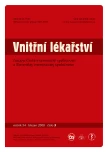The influence of rehabilitation on peak oxygen consumption in patients after myocardial infarction treated with beta-blockers
Authors:
V. Chaloupka; L. Elbl; S. Nehyba; I. Tomášková; Š. Chaloupková
Authors‘ workplace:
Interní kardiologická klinika LF MU a FN Brno, pracoviště Bohunice, přednosta prof. MUDr. Jindřich Špinar, CSc., FESC
Published in:
Vnitř Lék 2008; 54(3): 225-228
Category:
Original Contributions
Overview
The purpose of the study was to verify whether rehabilitation programs improve both stress tolerance and peak oxygen consumption (pVO2) plus the consumption of oxygen at the level of anaerobe threshold (AT) in patients after myocardial infarction treated with beta-blockers. Our objective was to find out the differences in changes in the above indicators in elderly patients.
The set of consisted of 2 groups of patients aged over 65 (56 ± 6.1) a ≥ 65 let (69 ± 4.7). The first group contained 96 and the second group 31 patients, respectively. Prior and after the rehabilitation program, stress echocardiography (SE) and symptomlimited spiroergometric test were performed in the patients.
Results:
A statistically significant improvement in stress tolerance and in the oxygen consumptions indicators was recorded in the group of younger patients (< 65 years of age), both at the peak and at the anaerobe threshold levels (p < 0.001). Patients aged 65 or older recorded a statistically significant improvement in stress tolerance (p < 0.01) on the one hand, but only minor, statistically insignificant improvement in pVO2 and AT oxygen consumption on the other.
Conclusion:
A two-month rehabilitation program improves both stress tolerance and the peak oxygen consumption in patients after myocardial infarction treated with beta-blockers. The improvement is statistically insignificant in elderly patients. The above finding supports our opinion that elderly patients need long-term controlled training which should be performed at regular intervals and with the necessary intensity.
Key words:
myocardial infarction – rehabilitation – peak oxygen consumption – anaerobe threshold
Sources
1. Van de Werf F, Ardissino D, Betriu A et al. Management of acute myocardial infarction in patients presenting with ST-segment elevation. The Task Force on the Management of Acute Myocardial Infarction of the European Society of Cardiology. Eur Heart J 2003; 24: 28-66.
2. Niederle P, Staněk V. Zásady péče o nemocné s chronickými formami ischemické choroby srdeční. Cor Vasa 1998; 15: 1300-1331.
3. Gordon NF, Duncan JJ. Effect of beta-blockers on exercise physiology: implications for exercise training. Med Sci Sports Exerc 1991; 23: 668-676.
4. Fletecher GF. Exercise training during chronic beta blockade in cardiovascular disease. Am J Cardiol 1985; 55: 110D-113D.
5. Pratt CM, Welton DE, Squires WG et al. Demonstration of Training Effect During Chronic Beta-adrenegic Blockade in Patients with Coronary Artery Disease. Ciculation 1981; 64: 1125-1129.
6. Working Group in Cardiac Rehabilitation and Exercise Physiology and Working Group on Heart Failure of the European Society of Cardiology. Recommendations for Exercise Testing in Chronic Heart Failure. Eur Heart J 2001; 22: 125-135.
7. Ko LK, McKelvie RS. The role of exercise training for patients with heart failure. Eur Med Phys 2005; 41: 35-47.
8. Lowenthal DT, Guillen GJ, Kendric ZV. Drug Effects. In: Pollock ML, Schmidt DH Heart Disease and Rehabilitation. 3rd ed. Human Kinetics 1995: 381-384.
9. Schmid JP. Exercise prescription based on heart rate: simple thing or science? Eur J Cardiovasc Prevention Rehab 2003; 10: 302-303.
10. Chaloupka V, Elbl L, Janoušek S et al. Exercise echocardiography early after myocardial infarction. Noninvasiv Cardiol 1995; 4: 66-70.
11. Mahler DA, Franco MJ. Clinical Applications of Cardiopulmonary Exercise Testing. J Cardiopulmonary Rehabil 1996; 16: 357-365.
12. Beaver WL, Wasserman K, Whip BJ. A new method for detecting anaerobic threshold by gas exchange. J Appl Physiol 1986; 60: 2020-2027.
13. Froelicher VF, Perdue S, Pewen W et al. Application of meta-analysis using an electronic spread sheet to exercise testing in patients after myocardial infarction. Am J Med 1987; 83: 1045-1053.
14. Show LJ, Peterson ED, Kesler K et al. A metaanalysis of predischarge risk stratification after acute myocardial infarction with stress electrocardiographic, myocardial perfusion, and ventricular function imaging. Am J Cardiol 1996; 78: 1327-1333.
15. Ghayoumi A, Raxwal V, Cho S et al. Prognostic Value of Exercise Tests in Male Veterans With Chronic Coronary Artery Disease. J Cardiopulm Rehab 2002; 22: 399-407.
16. Cully RB, Roger VL, Mahoney DW et al. Outcome After Abnormal Exercise Echocardiography for Patients With Good Exercise Capacity. J Am Coll Cardiol 2002; 39: 1345-1352.
17. Kavanagh T, Mertens DJ, Hamm LF. Prediction of Long-Term Prognosis in 12 169 Men Referred for Cardiac Rehabilitation. Circulation 2002; 106: 667-671.
18. Chaloupka V, Elbl L, Nehyba S et al. Stanovení intenzity tréninku u nemocných po infarktu myokardu léčených beta-blokátory. Cor Vasa 2005; 47 39-44.
19. Braunwald E. Heart Disease. A Textbook of Cardiovascular Medicine. 5th ed. Philadelphia: W.B. Saunders Company 1997: 1687-1703.
20. Fletcher GF, Balady GJ, Amsterdam A et al. Exercise Standards for Testing and Training. Circulation 2001; 104: 1694-1740.
21. Chaloupka V, Elbl L, Nehyba S et al. Vliv rehabilitace na vrcholovou spotřebu kyslíku u nemocných léčených betablokátory. Cor Vasa 2006; 48: 38.
22. Chaloupka V, Elbl L, Nehyba S et al. Rehabilitace po infarktu myokardu a revaskularizaci u starších nemocných. Vnitř Lék 2005; 51: 143-149.
Labels
Diabetology Endocrinology Internal medicineArticle was published in
Internal Medicine

2008 Issue 3
Most read in this issue
- Idiopathic retroperitoneal fibrosis - Ormond’s disease
- Von Willebrand disease
- SIADH as only paraneoplastic cause of the small cell lung cancer: case report
- Treatment of IgA nephropathy
